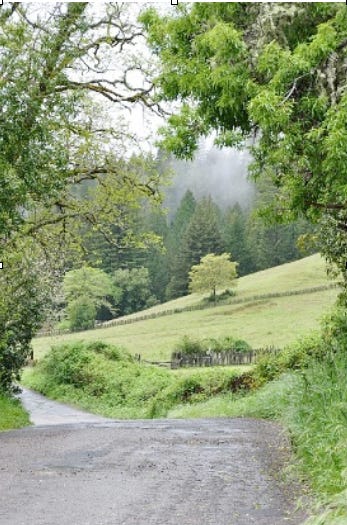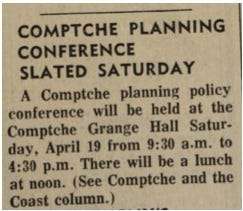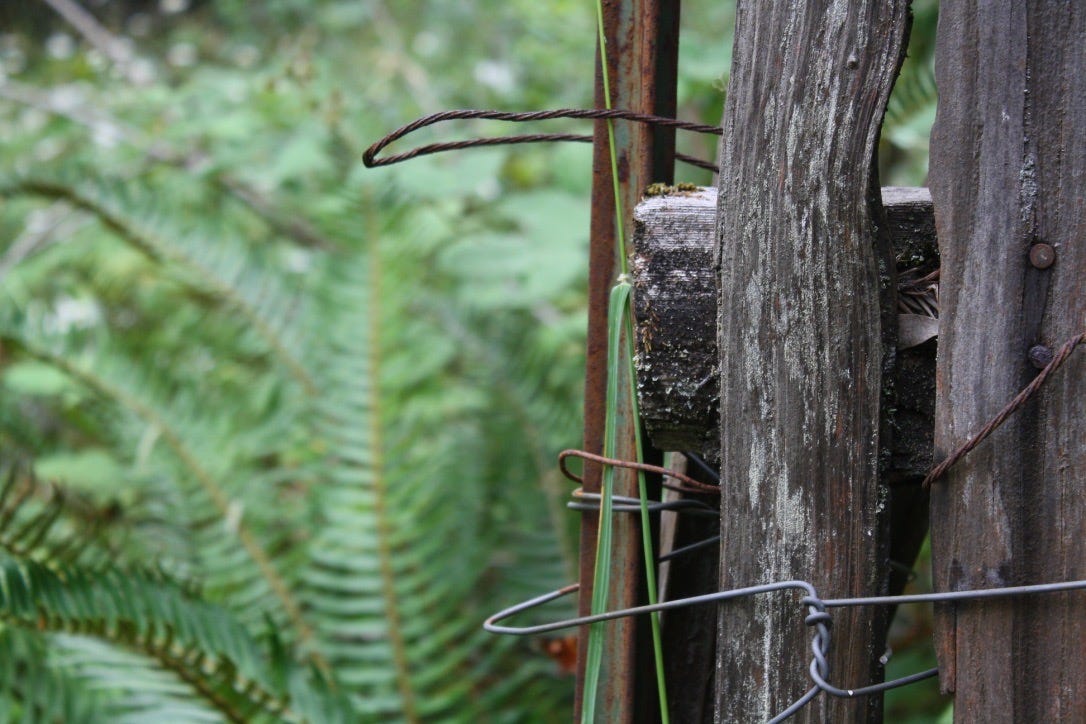During the 1970’s Comptche experienced dramatic growth and a changing population profile. Traditions that were established over one hundred years by timber families were being transformed by the newcomer nature lovers. The changing demographic presented a clash in values over land use and values. Ironically, the very issues causing conflict earlier in the decade became mediating factors by 1975.
A new tradition began. Town meetings discussing land use conflicts, like the air strip and dams, turned to other issues impacting community members. These meetings coincided with a countywide call for towns to organize Citizens Advisory Committees for planning, and residents of Comptche were ready to talk.
The Comptche Area Citizens Advisory Committee formed in 1975. Mendocino County Planning Division tasked each CAC with surveying their community, and then drafting a general plan for property zoning, land use, and services.
The three-year assessment project required regular local meetings. The Comptche Area CAC had fifteen members. They were the only town in Mendocino County to democratically elect their committee, according to their CAC Chair, Michael Nolan:
“The other committees were appointed by city councils, but we’re unincorporated. Comptche elected its committee.”
This advisory committee was an unexpected force of change. The group, comprised of old-timers and newcomers, worked together between 1975 and 1978 to create and write Comptche’s first general plan. Issues over land use were frequent topics of discussion and debate. Their report states that the community members “met as necessary to present their views until all felt heard.”
Opinions about community amenities and asset mapping were among the committee’s tasks. Working together, representatives of new and old-time residents asked questions, listened, took notes, and conducted a community survey. When they sat down together to look at the data, they saw themselves in the mirror.
Seeing through the eyes of the Other, they realized they saw eye-to-eye on most issues under consideration. They worked long and hard to develop goals and policies. They learned who the Other was. And then, they wrote this:
The people of Comptche historically have been independent and generally remain so today. Proudly individualistic, old and new residents alike agree that they hold their land dear. They respect the value that the world has put upon the unique products of their forests, but they also cherish the natural setting and covet the independence to be found in a sparsely populated community. Comptche is outwardly a very sleepy and quiet place, there is a good deal of private and community social life. Life in Comptche is a good life for the children, the young, the middle-aged, and older people.
Together, they created the Comptche Conservation Plan, written by newcomer Michael Nolan. This is the town’s first and only general plan. The process of doing the work, collecting data, and discovering each other—this is where essential exchanges happened. Relationships were built between the old-timers and the newcomers, and through relationships they established a process for resolving community conflict.
Some residents felt the zoning outcomes had flaws. One of the old-timers who served on the committee told me in an interview:
“They parceled property into two-acre minimums in the center of Comptche, at the store, radiating out to forty through eighty-acre minimum parcels. We can’t divide our parcels. What about our heirs?”
The Comptche General Plan is the result of participatory decision-making. Futurist Robert Theobald studied, wrote, and spoke about resilient communities. He wanted us to know how they function, what essential elements do they share? A key element of resilient communities is participatory decision-making.
The Comptche Conservation Plan is a living document, intended to stay current with desires and intentions of its’ population through periodic review. Relationships were written into this community process. One of the newcomers who served on the committee explained to me:
“It worked out because of peer-ness, finding a normal-ness among families and family ways. We discovered we had the same values, especially when we did the General Plan together.”
The CAC wrote a questionnaire for the community titled:
Comptche Area Attitude Survey: This survey is intended to determine the desires of the residents in the Comptche area.
Their findings in the mid-1970s reflected my findings in 2011 about household amenities (see Chapter 3 posts). The report is too long to include here, but what I found corroborates with my findings four decades later.
Community members did not want outdoor advertising, mobile home parks, nor a public park. The majority were not interested in establishing services prompted by the county such as “Regional Occupational Center” classes or a satellite community college.
True to their reasons for living in Comptche, residents in the 1970s opted to keep it simple. They asked merely for road improvements and a better community fire alarm system. They were content with “spending less and living more simply.”
The CAC experience produced outcomes similar to other studies in community conflict. In a study about civic decision-making and conflict mediation, Local Development and Citizen Participation, researchers found that, “citizen involvement in local development is the key to equality, inclusiveness and sustainability”.
The Comptche Conservation Plan ends with admirable transparency. The committee assessed their process on a page titled, How We Coped. They shared their challenges and how they worked through them.
“Between all of the Committee members, everybody in this area is known by someone on the Committee. All individuals—all different. All real people, not numbers”.
Each member had a respected point of view and each recognized they represented themselves and their constituents. Decidedly, committee members did not represent non-resident land owners.
“We found out that we were ladies and gentlemen. We had honor. We weren’t sneaky or mean. We still don’t agree on everything, but we aren’t trying to ‘get’ each other…. We agreed on every fundamental principle. No one wanted much growth… We don’t want a tourist trade here. We believe in ‘property rights’—our homes are our castles. We respect our neighbors’ rights to live their own way—and expect others to respect our ways.”
As elected as representatives, they acknowledged they each tended to be vocal and opinionated, but that “some of us can’t talk very well. Some of us can’t listen very well. Sometimes both.”
Using Roberts Rules of Order, they talked and listened for three years. “Sometimes people got tired and frustrated. Over time, we said what we really meant. We stopped being careful and got real.”
This is significant. It demonstrates the process of resolving community conflict takes time. Through time and the serendipity of a county mandate, residents of Comptche found their way to common ground.
Up next: Old-time Traditions of Dance Cabins to Chivarees
Resources for this post:
Nolan, Michael and the Comptche Area Community Advisory Committee, 1978. Comptche Conservation Plan
Meldon, Jeanne, Michael Kenny and Jim Walsh, 2004. “Local Development and Citizen Participation”, chapter in Participatory Governance: Planning, Conflict Mediation, and Public Decision-making in Civil Society
Smith, Michael D. and Richard S. Krannich, 2009. Culture Clash: Newcomer and Longer-Term Residents’ Attitudes Toward Land Use, Development, and Environmental Issues. Rural Sociology, 65(3) October 2009
Spicer, Lisa Gruwell, 2012, c 2024. Finding Common Ground: When the Hippie Counterculture Immigrated to a Rural Redwood Community
Theobald, Robert, 1997. Reworking Success: New Communities at the New Millennium









